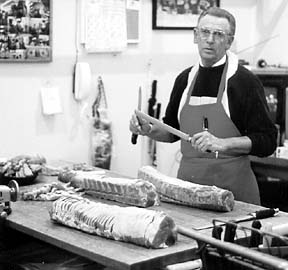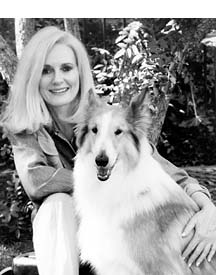Dog food as we know it today – that is, either crumbly bits of kibble packaged in bags and boxes or gloopy meat-based concoctions sealed into cans – was invented in 1860. Think about that for a moment. Our great-grandparents and great-great-grandparents raised dogs completely without the benefit of Purina. Before 1860, no one poured a pile of chow from a bag marked, “Dog.” Everyone who had a dog knew what dogs ate and how to feed them.
Considering how many thousands of years that dogs have survived while living in our homes and sharing our meals, it is interesting that most dog owners are shocked and perplexed when it is suggested that they might want to consider giving up their cans and bags of dog food.
Try this as a test: Tell one of your dog-owning friends you’ve read that dog food is not good for dogs, and she should stop feeding it. Her first question will be, “Well then, what WOULD I feed my dog?!”

The answer is food . . . real food . . . raw food, the kind of food that canines have been living and thriving on for the last few centuries! Yes, we are talking (mostly) about meat.
You may have noticed that in the last few years, nutrition experts have “rediscovered” the value of a Paleolithic diet for humans – one that includes far more fruits and vegetables and far fewer grains than we eat now, a certain amount of fresh meat, and certainly no dairy products.
Veterinary nutritionists (and holistic veterinarians) can likewise tell you about the many benefits of feeding your dog his ancestral diet. The actual recipes are speculative, of course, but there is no doubt about the major constituent of the diet: raw meat.
Duplicating this diet as closely as possible is said to have numerous benefits. Holistic veterinarians and breeders who utilize a raw-meat diet say that it can make itching dogs stop scratching. Thin, dull coats become thicker and shinier. Apathetic dogs regain enthusiasm for life. Females who have had difficulty conceiving or carrying puppies to term become pregnant and bear healthy puppies.
“Having raised animals on commercial pet food, and now, having raised animals on raw meat, there’s no comparison,” says Celeste Yarnall, a pet nutrition specialist and author of Natural Cat Care, and 1998’s Natural Dog Care. “Animals who are fed an appropriate raw-meat diet are alive, they glow from whisker to tail tip. They are happy and comfortable in their skins.”
Why is Raw Meat Better for Dogs?
There are numerous reasons why dogs might do better on a diet largely comprised of meat. Foremost, says Yarnall, is that dogs’ bodies are designed to produce only about 25 percent of the enzymes they need to digest their food; the remaining 75 percent should be within the food they eat. All raw foods contain the enzymes the body needs to digest the food. But when you cook foods, the enzymes are destroyed. In order to digest a food devoid of enzymes, the body needs to work overtime to produce its own digestive enzymes to break down the food.

Many holistic veterinarians believe the resulting wear and tear on the pancreas may be responsible, in turn, for other health problems. In her book, The Natural Dog, Mary Brennan, DVM, says that many research studies have linked enzyme deficiencies and diseases, both acute and chronic. To counter this, one can supplement the dog with digestive enzymes, or feed raw food! Cooking also destroys a large percentage of the food’s nutrients. Some foods lose as much as half of their vitamins when they are cooked.
And, finally, to some degree, cooking generates a certain amount of toxins in food. Raw food enthusiasts cite the fact that the number of white blood cells circulating in the bloodstream usually doubles or triples immediately following consumption of a cooked food meal; the number does not rise when raw food is eaten. A body that initiates an “attacking” immune response to every cooked meal wastes much of its precious resources sidetracked in a needless battle.
Overcoming the Raw Food Sceptics
It is a testament to our skeptical times that most people who feed their dogs raw food spend more of their time defending their decision than describing the benefits of their diets. Fortunately for us, that mean the experts were ready with answers to our typical questions:
What about the danger of bacteria and food poisoning?
Many people fear bacterial contamination and resultant food poisoning so much that they cannot entertain the idea of feeding their dog raw meat. To these people, Yarnall says, “So many dogs live with sub-clinical medical conditions all their lives, dying of cancer, kidney failure, liver disease, arthritis, and every other combination of the diseases . . . I’d rather take my chances against the bacteria, and feed the food that best supports dogs’ health.”
This is not to say that Yarnall and other raw feeders disregard the threat of contamination. Most use some method to disinfect the meat they feed their dogs and observe “safe-meat” handling techniques (see “Taking the Fear Out of Raw Feeding,” below, for more detail). These things put Yarnall’s mind completely at ease.
“Of course you have to practice safe hygiene. You have to be more intelligent than someone who uses a can opener to prepare their dogs’ meal. But the benefits outweigh the risks by so much,” she says.
Doesn’t raw food cost a lot?
There’s no doubt about it: feeding meat on a regular basis costs more than feeding dog food. But according to the experts, the improvement in the dog’s health will more than offset the price of the diet.
Yarnall says she could prove this one on a graph. “I don’t spend money having my veterinarian treat my dog for flea problems and allergies and fungus problems and heartworm and all the other diseases brought on by poor nutrition,” she says. “I spend my money on the food, instead.”
Dr. Brennan tells of a client who raised Yorkshire Terriers and Llasa Apsos, and was concerned about the increased cost of feeding a higher quality diet. However, at Brennan’s urging, she tried the diet, and in the next heat cycle, she saw a 75 percent improvement in her dogs’ conception rate, proving that the change was cost-effective to her business.
We should add that the above question made one raw feeder we spoke get angry. “So, if I want to save money I should raise my children on Top Ramen and generic Cheerios?” she exploded. “I tell people that if you can’t afford to feed three children properly, you shouldn’t have three children, and they understand me. But when I say that if you can’t afford to feed three dogs properly, you shouldn’t have three dogs, they come unglued. Why people will try to defend being cheap with the health and well-being of their loved ones is beyond me.”
Isn’t dealing with meat inconvenient?
Fortunately, the market takes care of all inconveniences. There are a number of companies springing up to cater to those who don’t want to take the time to select, buy, and prepare meat for their dogs. Others buy enough meat for a week or two or even a month, and spend a couple of hours on that day preparing and separating the food into individual portions that they then freeze. Then, each night they transfer the next day’s meal into the refrigerator, where it can thaw safely for feeding the next day.
Why would my veterinarian tell me to feed Brand X, if it is so bad for my dog?
We’ll let Celeste Yarnall answer this one: “If you feed your dog nothing but commercial pet foods, you will have a very happy veterinarian, because your dog will be a patient for life. Go on into the veterinarian’s office and get your bags and your cans, and you will come back with a dog who has cancer, with dripping orifices, with skin problems and allergies, and worse. Veterinarians are wonderful people, don’t get me wrong, but they have been educated very poorly in nutrition.
“Guess where most veterinarians got their education? Who donates the largest amounts of money to university vet schools? Guess who writes the textbooks? The pharmaceutical industry and the pet food companies, that’s who! So is it any wonder that the veterinarians are all taught that dogs are better off eating food from a bag or a can?”
I can see this diet working for wolves, but our modern dogs are vastly different animals . . . aren’t they?
Actually, the wolf and the dog are not that far apart. It’s true that we have bred them to look very different from their wolf ancestors, but what’s “under the hood” is still essentially the same. Dogs have been living with us for a long time, but they still have 42 shredding teeth; they haven’t suddenly grown big grinding teeth like ours!
Taking the Fear Out of Raw Feeding
The biggest objection that most people have to feeding their dogs a raw diet is the fear of poisoning their pets with bacteria-laden meat. Fortunately, there are a number of inexpensive and easy meat-management techniques you can employ to reduce bacterial contamination of the meat. Without lessening the importance of feeding bacteria-free food, let us mention that most raw-food feeders start out by aggressively disinfecting every bit of meat they serve to their dogs, and, when they find their dogs’ health improving, they relax a little. After all, a healthy dog with a robust digestive system full of beneficial bacteria ought to be able to digest meat in any condition.
Observe the following raw meat safety admonitions:
Buy meat from the most reputable sources
Fresh and clean are your watchwords. Look for a butcher shop that is immaculate; if it smells bad, or if the refrigerator cases don’t look sterile, don’t shop there. Choose a location that gets a lot of business; more turnover means fresher meat.
Disinfect any meat you are worried about
Depending on your level of confidence, you may wish to disinfect all meat you feed to your dog, or just the meat with an appearance or odor that undermines your trust.
Grapefruit seed extract and food-grade hydrogen peroxide are potent substances that are commonly and safely used to disinfect meat (they can also be used to clean fruits and vegetables!). Both are fairly inexpensive and both exhibit a powerful antibacterial action, even when diluted considerably.
Many raw feeders, including Celeste Yarnall, use grapefruit seed extract to disinfect their dogs’ meat. Yarnall mixes four drops of the extract into 6-8 ounces of purified water, and uses this to disinfect one pound of meat. Dr. Swift uses one tablespoon of 3% food grade hydrogen peroxide mixed into a cup of water per pound of meat.
Place the meat chunks into a clean glass or ceramic bowl and pour the liquid over it. Bacteria is generally introduced to the outside surfaces of meat, by touching a dirty counter, for instance, or being cut with a dirty knife. When dealing with chunks of meat, your concern is only for the exposed surfaces. (If feeding ground meat, use the grapefruit seed extract formula, which can be mixed right into the meat and served to the dog without harm.) Cover the bowl and allow it to “marinate” in the refrigerator for an hour or so. Afterward, rinse the meat off in clean water; it’s ready to feed or freeze.
Keep meat cold
Unless you’re careful, there are unlimited opportunities for meat to warm up while in your care; don’t let it. Meat begins to spoil above 40 degrees F. Cold temperatures inhibit the growth of the bacteria that causes spoilage, so stop at your favorite butcher shop right before you drive home; if you shop in a supermarket, select the meat right before you go to the checkout line. Put meat in the refrigerator before unpacking your other groceries.
Take the meat out of the refrigerator just before you prepare it.
When using frozen meat, thaw it in the refrigerator. It takes longer, but it keeps the outermost portion from warming to temperatures above 40 degrees while the rest is still thawing.
Use fresh meat quickly
The United States Department of Agriculture recommends using fresh beef within three to five days of purchase. However, the USDA food safety experts suggest using ground meats, and all poultry and organ meats within one to two days of purchase. Again, while refrigeration inhibits the growth of bacteria, the cold temperatures do not stop spoiling altogether.
Keep your kitchen clean
There is probably a greater chance of meat becoming contaminated in your kitchen than in most butcher shops, because butchers religiously practice “safe-meat” practices.
Start out, like a butcher, with a clean theater of operations. Don’t let the meat touch any surface that has not been disinfected. Make sure that all your cutting boards, counters, knives, and dishes are pristine before bringing out the meat.
As you handle the meat – unwrapping it, cutting it up, mixing it with other things, putting it in a dish, and disposing of the wrapping – remember to “detoxify” everything the meat touched with an anti-bacterial agent. This includes your hands, the counter you set the meat on, the knives or cutting board you used, the sink, the sponge, any dishes you touched, and anything else your unclean hands touched. This especially includes the dog’s bowl.
If the meat actually were contaminated, any uncleaned surface in your kitchen could be infected with bacteria, which, in turn, could lurk behind and contaminate another meal. However, if you followed its trail with a potent disinfectant, you would eliminate all the possibilities for it to lurk behind and “spoil” another day.
How to Feed Meat
OK, let’s assume you are sold. How do you go about formulating a raw-meat diet?
Recipes for home-made dog food abound, and every book on our resource list (see “Raw Resources”) includes at least one. But despite numerous small variations of opinion regarding supplements, the basic proportions of raw meat to grains to vegetable matter is roughly the same.
Yarnall suggests formulating a diet that is comprised of about 40 percent meat, and 30 percent vegetables, and 30 percent grains. She uses about 60 percent muscle meat and about 40 percent of organ meat (kidneys, liver, or heart). The vegetables vary, and are prepared, raw, in a food processor. Yarnall uses only slow cooked oatmeal (the 30-minute type) or barley flakes. She adds enough purified water to make the mixture the consistency of a thick chili. Yarnall supplements this food with an essential fatty acid supplement and a small amount of bone meal.
For comparison, McKinnon uses a diet comprised of about 30-40 percent meat, fish, or eggs, 40-50 percent grains, and 20 percent vegetables. Some raw feeders eschew the use of grains altogether, since grains are not technically part of the dog’s ancestral diet. Dr. Russell Swift, a Florida veterinarian who has had a long-time interest in pet nutrition, was among the first to question the need for grains in dog food. His recipe for home-made dog food (published in the March 1998 issue of WDJ) contains a smaller amount of grain than many authorities. He suggests using just 1/4 cup of oats or multi-grain hot cereal and 1/4 to 1/2 cup of chopped raw vegetables to every 1/2 pound (about a cup) of raw meat.
Most raw food enthusiasts size the dog’s meals at about two to three percent of the dog’s body weight daily. (A 50-pound dog would get 1 to 1 1/2 pounds of food a day.) Watch your dog’s weight and condition and adjust the amount accordingly – reduce the amount if he starts gaining weight, increase the amount if he begins to get too slim.
That last advice may sound unscientific, but it’s not. It’s representative of the kind of thinking – the whole mindset – that you should bring to the task of feeding meat to your dog. It’s simple. It’s intuitive. It’s natural. It’s how dogs are supposed to eat.







Neither humans nor dogs need grains of any sort. My collie used to just love chicken viscera. Our chickens are grains bugs and greens.